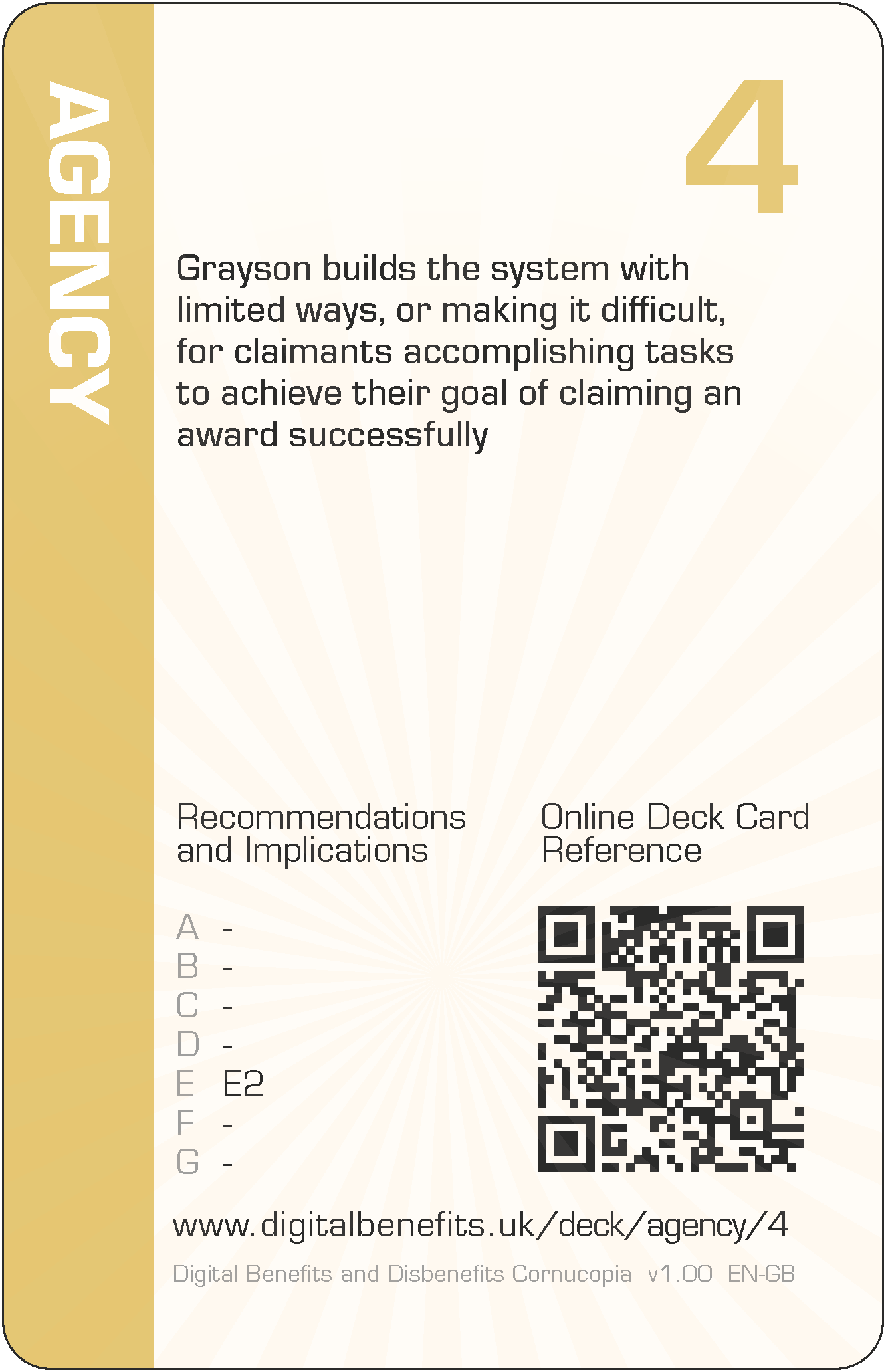Agency 4 (AG-4) Card
DBD Cornucopia > Deck > Agency > 4
Card Details - Four of Agency
Abbreviation
AG-4
Card's focus
The focus of this card is hurdles for claimants
Threat to claimants
Grayson builds the system with limited ways, or making it difficult, for claimants accomplishing tasks to achieve their goal of claiming an award successfully

Threat to claimants
Grayson builds the system with limited ways, or making it difficult, for claimants accomplishing tasks to achieve their goal of claiming an award successfully.
Some examples of how this threat could lead to harms (negative effects on claimants)
The design recommendations and implications relevant to the card are listed below in the next section, but even those can be somewhat abstract and difficult to think about during practical day-to-day implementation. Therefore, some example harms are provided to complement the more formal research outputs. These examples are unique per card, and are only published on these web pages (i.e. in no other project outputs).
- Claimants feel like they cannot do much or anything themselves and become demotivated or give up
- The systems and processes for arranging compulsory (sanction-enforced) telephone appointments with government officials do not take into account the realities of claimants' short-notice work schedules, which may only be notified a few days in advance, and late changes which can occur with less than 24hrs notice, with consequent missed appointments and resultant penalties
- Validation of claimant-provided data is undertaken offline, adding long delays to making the initial claim and thus first payment
- Claimants are asked for information which they do not have immediately to hand, but which blocks their progress
- While physically present face-to-face with a government official, claimants are asked to complete an activity by accessing the online channel with their own device and own internet connection
- While remote using a digital channel, claimants are asked to attend a physical government office location to complete an activity
- Claimants are subjected to continuous or repeated time-based eligibility reassessment even when there are have been no changes which affect eligibility, creating extra unnecessary work
The examples are to help understand the threat on the card, not to suppress thinking and innovation. Incorporating these examples exactly, or closely matching ones, should be scored down when playing DBD Cornucopia as a game.
Applicable design recommendations and implications
These are reproduced here from Research Briefing N
Design systems which support the division of labour with claimants' ecosystems
- Expand claimant autonomy, control and choice, backed up by transparency of actions and activities
Enable claimants to better engage with digital welfare and empower them to make their own choices and decisions. Attribute information sources, other advice and decisions; build in logging and audit trail generation; provide access to records of what information was used to make choices/decisions and by whom; provide mechanisms for claimants to question, discuss and challenge actions, provide feedback, and make complaints.
General Notes
Card values (i.e. '4' for this card) are for game play and are not correlated with the severity of harm. This is because threats cannot be ranked directly since they can affect individuals in different ways due to situations and circumstances, or affect fewer or more claimants, or the harms can arise in claimants' support networks and wider society.
The threat description uses a person's name as the "attacker" (i.e. 'Grayson' for this card), which can be thought of someone involved with implementation. They could have any role which influence digitisation. So they could be a database administrator, or a copy writer, or a quality assurance specialist, etc, or all of these. Everyone could have some influence on the claimant threat described. The names were randomly selected from those currently most popular as given names for boys and girls (UK Office for National Statistics).
The example harms provided are drawn from the research data (which explored not only parts of existing services but also the effects of possible changes to those), from the author's own knowledge of web application development and testing, the author's own experience of helping citizens to claim Universal Credit (UC) and Personal Independence Payment (PIP), and from suggestions submitted by other people (make a suggestion). The threats and example harms do not necessarily exist in the current UC or PIP deployments or in ecosystems around those services, but they might well do.
All the cards in this Agency suit are: 2 3 4 5 6 7 8 9 10 J Q K A
The other suits in the deck are: Scope, Architecture, Trust, Porosity and Cornucopia (plus Jokers).
